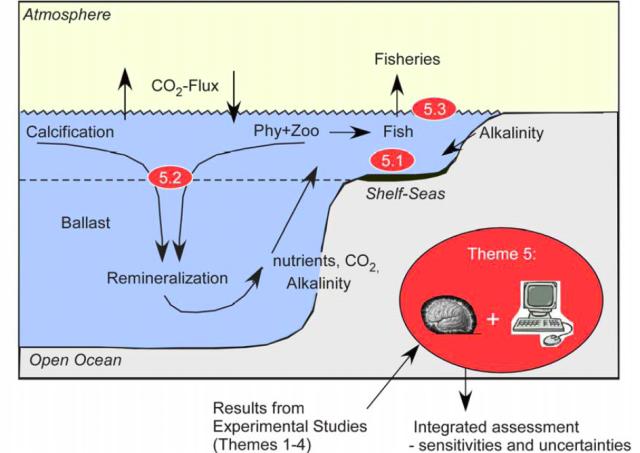BIOACID I – Theme 5: Integrated Assessment: Sensitivities and Uncertainties
- Synthesize information obtained in Themes 1 to 4 in order to achieve an integrated understanding of biological responses to ocean change.
- Develop a framework for integrating ocean acidification sensitivities at the organism level into ecosystem models.
- What are the integrated effects of ocean acidification and warming on ecosystem to global ocean scales?
- What are the critical threshold levels (‘tipping points’) of ocean acidification for irreversible ecosystem changes?
- What is the most suitable definition of dangerous ocean acidification in terms of the goods and ecosystem services lost due to OA?
In its Special Report “The Future Oceans – Warming up, Rising High, Turning Sour”, the German Advisory Council on Global Change (WBGU, Berlin 2006) recommends a guard rail for future ocean pH decrease of 0.2 units as a margin of safety according to the precautionary principle. This suggestion is motivated by the intention of avoiding an aragonite undersaturation in the ocean surface layer. As stated in the report, the tolerable window for ocean acidification defined by WBGU presently relies on an extremely small data base. In fact, rather than using the limited data on observed biological consequences of ocean acidification, the WBGU reaches its recommendation on the basis of projected changes in water chemistry (aragonite saturation state). While this is an appropriate approach in view of the scarcity of biological information, there is a clear need to establish a reliable data base on tolerance levels for ocean acidification in key groups of ocean-acidification sensitive marine organisms in order to reach a more informed recommendation.
Theme 5 of BIOACID will take the challenge of integrating the information gained under Themes 1 to 4 in order to identify the potential thresholds associated with ocean acidification. Uncertainties, probabilities and risks to the marine environment have to be assessed as well as their feedback to climate system. This will be achieved through a meta-analysis of process studies and process parameterisations, and by combining models and data in a data-assimilative framework. In return, feedback from the modelling work will inform the experimental work in BIOACID about uncertainties in models and the relevant process parameterisations.
During the first 3-year phase of BIOACID, our main aim is to develop and establish the tools that will allow us to fulfil the BIOACID synthesis needs. For the three subprojects proposed here, the synthesis tools to be established within BIOACID range from meta-analysis techniques over regional and global numerical ecosystem models to economic methods of integrated assessment. These tools will help to better understand ongoing changes in chemical and biological state of the North Sea from alkalinity fluxes originating from the Wadden Sea over a synthesis model that integrates OA sensitivities at organism level into a North Sea ecosystem model (5.1) to an economical impact assessment. (5.3). Newly developed assessment tools will also be used to improve parameterisations of calcium carbonate production in global biogeochemical climate models (5.2). By investigating the combined effects of variations in temperature and ocean acidity, such parameterisations will allow to put better constraints on possible threshold levels on ocean acidification in a warming world.
